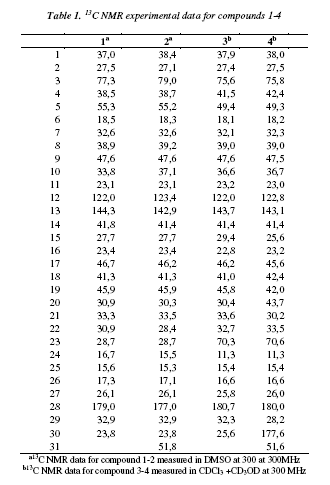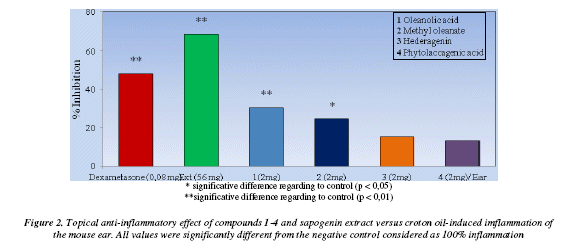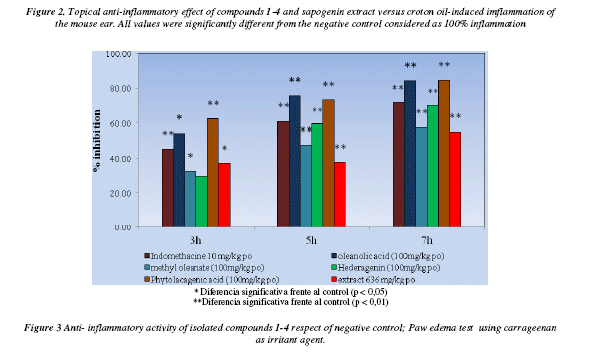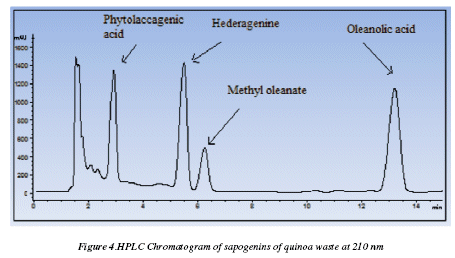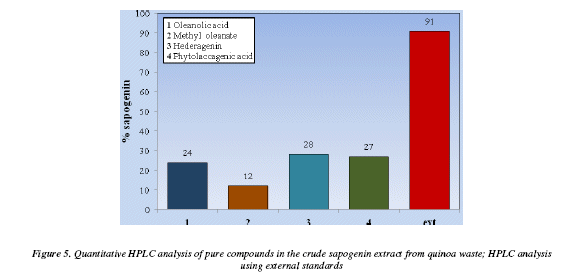Revista Boliviana de Química
versión On-line ISSN 0250-5460
Rev. Bol. Quim vol.30 no.2 La Paz 2013
ARTICULO ORIGINAL
EFFECT IN ACUTE INFLAMMATION OF SAPOGENIN EXTRACT AND ISOLATED SAPOGENINS FROM QUINOA WASTE (CHENOPODIUM QUINOA WILLD)
Maribel Lozanoa,b, Eduardo Gonzalesb, Yonny Floresa, Giovanna R. Almanzaa,*aLaboratorio de Bioorgánica, Instituto de Investigaciones Químicas, Universidad Mayor de San Andrés, Calle 27 Cota Cota, P.O.Box. 303 La Paz-Bolivia;b Laboratorio de Farmacología, Instituto de Investigaciones Fármaco Bioquímicas, Universidad Mayor de San Andrés Av. Saavedra 1995, La Paz Bolivia* giovyalmanza@yahoo.com.ar
Received 22 10 2013
Keywords: Sapogenins, Chenopodium quinoa, acute anti-inflammatory activity, ear edema model, paw edema model.
ABSTRACT
A sapogenin extract was obtained from quinoa waste (Chenopodium quinoa Willd) and analyzed by HPLC, as well as other chromatographic and spectroscopic methods, determining four major constituents: Oleanolic acid 1, methyl oleanate 2, hederagenin 3 and phytolaccagenic acid 4. The acute anti-inflammatory activity of both, isolated sapogenins and sapogenin extract, were evaluated in two animal models, carrageenan-induced paw edema and croton-induced ear edema, determining that the extract shows anti-inflammatory activity significant in ear edema model, greater than the compounds, suggesting a synergistic effect between the compounds, while in the paw edema model the isolated compounds show a significant anti-inflammatory activity while the extract shows only a moderate anti-inflammatory activity.
RESUMEN
A partir de residuos de quinua real (Chenopodium quinoa Willd) se obtuvo un extracto de sapogeninas el cual fue analizado por cromatografía HPLC, además de otros métodos cromatográficos y espectroscópicos, determinándose 4 constituyentes mayoritarios: ácido oleanólico 1, oleanato de metilo 2, hederagenina 3 y ácido fitolaccagenico 4. La actividad antiinflamatoria aguda fue evaluada mediante dos modelos animales, modelo de edema de oreja de ratón inducido por aceite de croton y edema de pata inducido por carragenina, determinándose que el extracto muestra una actividad antiinflamatoria significativa en el modelo de edema de oreja, mayor que los compuestos, sugiriendo un efecto sinérgico entre ellos; mientras que en el modelo de edema de pata se observa una actividad antiinflamatoria significativa en los compuestos aislados y solo una actividad antiinflamatoria moderada en el extracto.
INTRODUCTION
Inflammatory diseases are currently treated with steroidal and non-steroidal anti-inflammatory drugs (NSAIDs). NSAIDs exert their effects by inhibiting the metabolism of arachidonic acid, by both cyclo-oxigenase and lipoxygenase enzyme pathways.[1] Despite their widespread use, NSAIDs are often associated with severe adverse effects; the most common being gastrointestinal bleeding.[2] For this reason, safer compounds with less side effects are needed.
Bolivia is the first exporter of quinoa generating tons of quinoa waste each year. This quinoa waste does not have application and contents around 20% of saponins [12]. The hydrolysis of those saponins can produce sapogenins as oleanolic acid which have several studies about its anti-inflammatory effects [5]. The anti- inflammatory effect of Oleanolic acid was first reported in 1960s [3] where the inhibition of carrageenan-induced rat paw edema was showed and later was confirmed by other studies [4]. The other sapogenins have similar structures and can have similar anti-inflammatory effects than Oleanolic acid. In view of those antecedents, in the present work we have studied the activity of sapogenin extract and pure sapogenins in different inflammatory tests to observe the best administration vie and possible synergy among the compounds.
RESULTS AND DISCUSSION
Isolated Compounds from quinoa waste
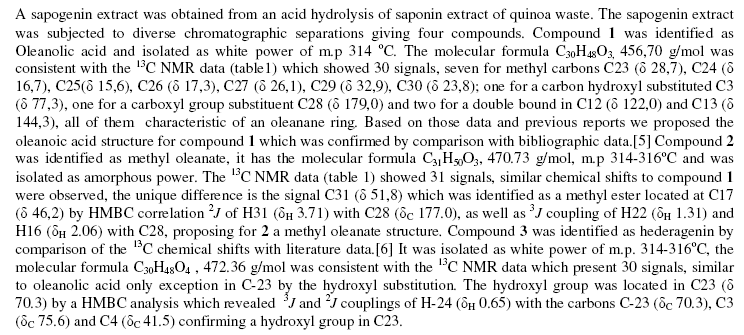
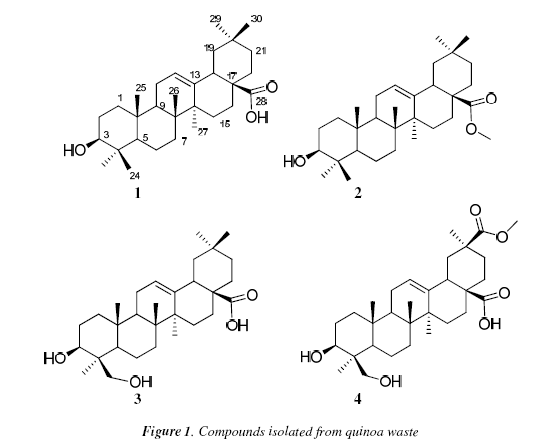
Compound 4 was identified as phytolaccagenic acid; by comparison of experimental 13C chemical shifts with literature data, it was also isolated as an amorphous white power, m.p 281 -284 °C, with a molecular formula, C31H48O6, 516.36 g/mol. The 13C NMR spectrum showed 31 carbon signals (table1) similar to oleanolic acid except by the presence of an ester group located in C-30 confirmed by analysis of the HMBC spectrum.[5]
Anti- inflammatory activity Ear edema test
Compounds 1-4 and sapogenin extract were submitted to the croton oil ear test, at the dose of 2 and 56 mg/ear, to evaluate the topical anti-inflammatory effect. As showed in figure 2, all pure compounds 1-4 exerted some anti-inflammatory activity, while sapogenin extract showed strong active, inducing 68,2% edema inhibition at the highest administered dose (56 mg/ear). Consequently, the contribution to the activity of the extract could be very interesting for mew pharmaceutical formulations by topical application.
Paw edema test
The development of edema induced by carrageenan corresponded to the events in the acute phase of inflammation mediated by histamine, bradykinin and prostaglandins produced under an effect of cyclooxygenase.[7] Sapogenin extract and compounds 1-4 had an anti-inflammatory effect at 636mg/kg po and 100mg/po, respectively, observable to 3 (p< 0,05), 5(p< 0,01) and 7(p<0,01) hours, respectively (figure 3). In this test, the compounds 1-4 had higher anti-inflammatory between 5-7 hours after treatment, while the activity of the sapogenins extract was less respect to compounds. The strong activity of oleanolic acid and phytolaccagenic acid could be employed for anti-inflammatory drugs of oral administration
HPLC analysis of sapogenins
The HPLC analysis revealed the presence of four triterpenic compounds in quinoa waste identified by external standard and the purity peaks (purified compounds 1-4) verified by UV (DAD, 210 nm) spectra (figure 4). Oleanolic acid (13,3 min), methyl oleanate (6,2 min), hederagenin (5,4 min) and Phytolaccagenic acid (2,8 min). A subsequent HPLC quantification of sapogenin extract, give the follow yields for the pure compounds: 24% Oleanolic acid, 12% methyl oleanate, 28% hederagenin and 27% Phytolaccagenic acid. The extract contents 91% of sapogenins (Figure 5). This composition could be used for the analysis of the strong topical anti- inflammatory activity of the extract.
CONCLUSION
The quinoa waste is generally considered for its higher content in saponins while triterpenoid sapogenins are not equal considered. An interesting pharmacological activity was observed for the sapogenin extract and isolated sapogenins, which can be considered of therapeutical relevance for quinoa waste in pharmaceutical formulations against inflammatory disorders. The HPLC analytical method set up here was fit for the determination of sapogenins in the extract, as a mean to control the quality of bioactive extract which could be obtained in big quantities from quinoa waste. Furthermore, the quinoa waste could also be a cheap primary material to obtain sapogenins extract or individual sapogenins with anti-inflammatory propierties.
EXPERIMENTAL
Extraction and isolation
The modified method of San Martin and Briones [8] was used for saponins extractions; first 500 g of ground sample was extracted with an aqueous solution of ethanol 50% v/v (ratio 1:9) for 3 h under constant stirring at 200 rpm. The extract was then filtered and ethanol was removed using a rota-evaporator and the water residue was dried by frizzed. 20g of saponin extract was hydrolyzed with 200ml of 2N HCl in 50% aqueous ethanol under reflux for 3h at 85°C, and therefore sugars and aglicones were separated. The solid phase sapogenins were washed with H2O and NaHCO3 at 5% m/v, this residue was dried using high vacuum pump by 7h.[9], [10]
6,2g was subjected to Vacuum Liquid Chromatography (VLC) silica gel chromatography using mixtures of petroleum ether/EtOAc (EtOAc: 10, 20, 30, 40, 50, 70, 80, 100 %, v/v) and EtOAc/ MeOH (MeOH: 5% v/v) as a gradient solvent system to give ten fractions. The fraction 2 consist of pure compound oleanolic acid 1 and fraction 9 pure phytolaccagenic acid 4. The pure compounds 2 and 3 were obtained by further silica gel flash chromatography using ether/EtOAc 90% and40 % v/v.
HPLC chromatographic analysis of sapogenins
Quantification of oleanolic acid 1, methyl oleanate 2, hederagenin 3 and phytolaccgenic acid 4 were performed on an HPLC system (Agilent, 1100 series) equipped with quaternary pump, DAD detector and Eclipse Plus C18 column (125x4,6, 5¡am). All these four compounds were detected at 210 nm at room temperature with an eluent flow rate of 1.0 mL/min. The mobile phase consisted of formic acid (0,1%) (A) and methanol (B) with a ratio of 15:85 (A:B, v/v) and isocratic elution.[1 1]
Animals
Experiments were performed on females Swiss mice (24 -26g), housed in controlled room temperature (20 ±2 °C) under a 12: 12h light-dark cycle (lights on 7 a.m.). Animals were kept in groups of 6 in light cages and had a free access to standard laboratory diet (pellets) and tap water in their cages.
Administration of extracts, fractions, isolated compound and drugs Croton-induced ear edema
The topical anti-inflammatory activity was evaluated as inhibition of the croton oil-induced ear edema in mice (CYTED, 1995ref) at doses of 2 mg/ear for the pure compounds and 56 mg/ear for the sapogenin extract, to the right ear of each mouse was administered mean dose and after mean hour was administered the other mean dose. Inflammation was induced on the inner surface of the right ear of mice, by application of 20¡aL of Croton oil, suspended in the appropriated vehicle, In the left ear was only applied the vehicle. Control animals received only the irritant solution, whereas the other mice received both the irritant and the test substances: At the maximum of the edematous response, 4 h later, mice were sacrificed and a plug (6mm Ø) was removed from both the treated (right) and the untreated (left) ears. The edematous response was measured as the weight difference between the two plugs. The anti-inflammatory activity was expressed as percentage of the edema reduction in treated mice in comparison to control mice. As a reference, the non-steroidal anti-inflammatory drug (NSAID) Dexamethasone (0.04 mg/ear) was used.
Carrageenan-induced paw edema
Pure compounds and sapogenin extract in 100 mg/kg p.o. and 636 mg/kg p.o., indomethacin in 10 mg/kg p.o. doses were given to rats orally by feeding tube. One hour after of administration, 0,05 ml (1% w/v) carrageenan solution was subcutaneously injected into the plantar surface of the left hind paw. The paw volume was measured with bernier, at 1, 2, 3, 5 y 7 hours after carrageenan administration . The anti-inflammatory activity in animals of pure compounds and sapogenins extract were compared with that of indomethacin and control groups.
Statistical analysis
Values are presented as mean ± S.E.M. Independent samples t-test and analysis of variance (ANOVA, Dunnett method) were used for the evaluation of data and P005 was accepted as statistically significant
ACKNOWLEDGEMENTS
This work was supported by the "Development of natural phytotherapeutic products" project financed by FEMCIDI/OEA and "Research on plant biodiversity" project financed by the Swedish agency SIDA/UMSA.
REFERENCES
[I] INSEL, P.A., Analgesic, Antipyretic and Antiinflammatory Agents and Drugs Employed in the Treatment of Gout. McGraw-Hill, New York1996, pp. 617 657. In: J.G. Hardman, Limbird, L.E. (Eds.),
[2] FUNG, H.B., KIRSCHENBAUM, H.L., Clinical Therapeutics, 1999, 21, 1131-1157. [ Links ]
[3] GUPTA, M.B., BHALLA, T.N., GUPTA, G.P., MITRA, C.R., BHARGAVA K.P. European Journal of Pharmacology, 1969, 6, 67-70 [ Links ]
[4] JIE L. Journal of Ethnopharmacology, 1995, 49; 57-68 [ Links ]
[5] FLORES, Y., DÍAZ, C., GARAY, F., COLQUE, O., STERNER, O., ALMANZA. G.R., Revista Boliviana de química, 2005,1, 22 [ Links ]
[6] MEHTA, B. K, MEHTA, D., AMRITA, I., Carbohydrate Research, 2004, 339; 2871-2874 [ Links ]
[7] NSONDENTANDOU, G.F, BANZOUZI, J.T., MBATCHIA, B., ELION-ITOU, R.D.G., ETOU-OSSIBI, A.W., RAMOS, S., BENOIT-VICAL F., ABENA, A.A., OUAMBA, J.M., Journal of Ethnopharmacology 2010, 127; 108-111 [ Links ]
[8] SAN MARTÍN, R., BRIONES, R. Journal of the Science of Food and Agriculture, 2000, 80: 2063- 2068. [ Links ]
[9] TIWATT, K., THONGPHASUK, P., CHAMULITRAT, W., WINK, M.. Phytochemistry 2008, 69; 1919-1926 [ Links ]
[10] DICK M.H., LIMBURG, H., GILLES, T., MARVIN H.J.P. J Sci Food Agric, 2000, 80:152-156 [ Links ]
[11] CHUNHUA, Z., CHEN, K., SUN, C., CHEN, Q., ZHANG, W., LI, X. Biomed.Chromatogr, 2007, 21, 755-761. [ Links ]












 uBio
uBio 
